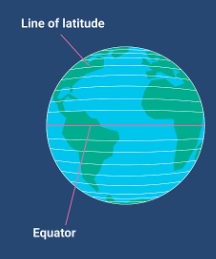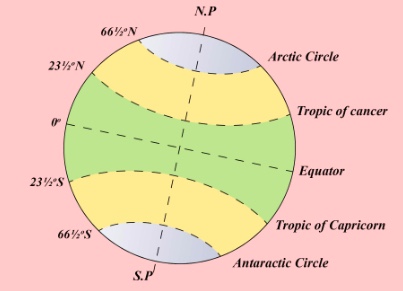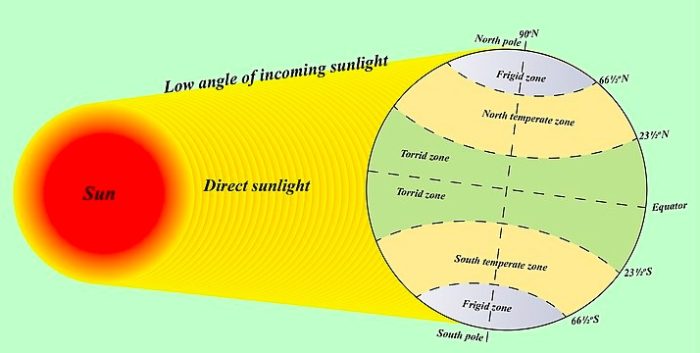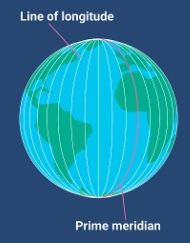Chapter 2 Notes
Latitude and Longitudes
Class 6 – Social Science
| Class | Class 6 |
| Subject | Social Science |
| Chapter Name | Latitude and Longitudes |
| Chapter No. | Chapter 2 |
| Category | Class 6 Geography Notes |
Question 1 What is the shape of Earth?
Question 2 What is a globe?
Question 3 What are the characteristics of globe?
Question 4 What are the limitation of globe?
Question 5 Define an axis, poles, North pole, South Pole, Equator, Northern and Southern Hemisphere.
Question 6 What are parallels or lines of latitude?
Question 7 Write the characteristics of parallels or lines of latitude.
Question 8 What are the important parallels of latitude?
Question 9 Why Earth is divided into different heat zone?
Question 10 Describe major heat zones of India.
Question 11 Differentiate between Latitude and Longitude?
Question 12 Write the characteristics of meridians or lines of longitude.
Question 13 What is Prime Meridian?
Question 14 What is Earth’s grid or geographic grid?
Question 15 What is the purpose of Time zones?
Question 16 Why is standard time needed for every country?
Question 17 How does the time of a place depend on its longitude?
Question 18 Define Indian Standard Time.
Question 19 Why does the torrid zone receive maximum amount of heat?
Question 20 Why is it 5.30 p.m. in India and 12.00 noon in London?
Question 21 What are the uses of globes?
Question 22 What is the total number of latitude and longitude?
Question 23 What is the time difference between the eastern most and western most parts of India if standard meridian is not adopted?
Question 24 Why is Frigid Zone very cold?
Question 25 How latitude and longitude is expressed?
Question 26 How does time vary with longitudes around the earth?
Contents
Shape of the Earth
Our planet earth is not a sphere but is slightly flattened at the North and the South Poles and bulge in the middle.
Globe is a true model (miniature form) of the Earth.
Globes may be of varying size and type – big ones, which cannot be carried easily, small pocket globes, and globe-like balloons, which can be inflated and are handy and carried with ease.
The globe is not fixed. It can be rotated the same way as a top spin or a potter’s wheel is rotated.
On the globe, countries, continents and oceans are shown in their correct size. It is difficult to describe the location of a point on a sphere like the Earth.
Limitation of Globe
(1) It is difficult to carry a globe.
(2) The space on globe is limited and details cannot be shown on it.
(3) A globe cannot be made for a part of the Earth.
(4) Details of the geographic features cannot be shown properly.
(5) It is difficult to handle a big size globe.
Axis is an imaginary line that passes through the center of the Earth and on which the Earth rotates.
The end point of the axis of the Earth is called the Poles.
The pole which points towards the Pole star is called the North pole.The other is called South pole.
Earth rotates from west to East.
An imaginary line midway between the North Pole and South Pole which divides the Earth into two equal parts or hemisphere is called Equator.
The northern half of the earth is known as the Northern Hemisphere and the southern half is known as the Southern Hemisphere. They are both equal halves. Therefore, the equator is an imaginary circular line and is a very important reference point to locate places on the earth.
Parallel or Lines of Latitudes
The imaginary lines running from east to west which are parallel to the equator are called parallels or lines of latitudes.
(1) Latitudes are measured in degrees.
(2) The equator represents the zero degree latitude.
(3) Since the distance from the equator to either of the poles is one-fourth of a circle round the earth, it will measure ¼th of 360 degrees, i.e. 90°.
(4) Thus, 90 degrees north latitude marks the North Pole and 90 degrees south latitude marks the South Pole.
(5) As such, all parallels north of the equator are called ‘north latitudes.’ Similarly all parallels south of the equator are called ‘south latitudes.’
(6) The value of each latitude is, therefore, followed by either the word north or south. Generally, this is indicated by the letter ‘N’ or ‘S’.
For example: Both Chandrapur in Maharashtra (India) and Belo Horizonte in Brazil (South America) are located on parallels of about 20° latitude. But the former is 20° north of the equator and the latter is 20° south of it. We, therefore, say that Chandrapur is situated at 20° N latitude and Belo Horizonte is situated at 20° S latitude.
(8) As we move away from the equator, the size of the parallels of latitude decreases.
(9) All the parallels are located at an equal distance from the equator towards the poles.
Important Parallels of Latitude
Besides the equator (0°), the North Pole (90°N) and the South Pole (90° S), there are four important parallels of latitudes–
(i) Tropic of Cancer (23½° N) in the Northern Hemisphere.
(ii) Tropic of Capricorn (23½° S) in the Southern Hemisphere.
(iii) Arctic Circle at 66½° north of the equator.
(iv) Antarctic Circle at 66½° south of the equator.
Heat zones of Earth
(1) Torrid zone: The mid-day sun is exactly overhead at least once a year on all latitudes in between the Tropic of Cancer and the Tropic of Capricorn. This area, therefore, receives the maximum heat and is called the Torrid Zone.
(2) Temperate Zones: The mid-day sun never shines overhead on any latitude beyond the Tropic of Cancer and the Tropic of Capricorn. The angle of the sun’s rays goes on decreasing towards the poles. As such, the areas bounded by the Tropic of Cancer and the Arctic Circle in the Northern Hemisphere, and the Tropic of Capricorn and the Antarctic Circle in the Southern Hemisphere, have moderate temperatures. These are, therefore, called Temperate Zones.
(3) Frigid Zones: Areas lying between the Arctic Circle and the North Pole in the Northern Hemisphere and the Antarctic Circle and the South Pole in the Southern Hemisphere, are very cold. It is because here the sun does not rise much above the horizon. Therefore, its rays are always slanting and provide less heat. These are, therefore, called Frigid Zones (very cold).
Meridian or Lines of Longitude
Tonga Islands (in the Pacific Ocean) and Mauritius Islands (in the Indian Ocean) are situated on the same latitude (i.e., 20° S). Now, in order to locate them precisely, we must find out how far east or west these places are from a given line of reference running from the North Pole to the South Pole.
These lines running from north to south, which joins the poles are called the meridians or lines longitude.
(1) The distances between them are measured in ‘degrees of longitude.’ Each degree is further divided into minutes, and minutes into seconds.
(2) They are semicircles and the distance between them decreases steadily polewards until it becomes zero at the poles, where all the meridians meet.
(3) All meridians are of equal length. Thus, it was difficult to number the meridians.
In 1884 all countries decided that the count should begin from the meridian which passed through Greenwich, where the British Royal Observatory is located. This meridian is called the Prime Meridian.
(4) Prime Meridian as the starting meridian is marked as 0° longitude. The Prime Meridian and 180° meridian divide the earth into two equal halves, the Eastern Hemisphere and the Western Hemisphere. There are 180 meridians towards the east of the Prime Meridian and 180 meridians towards the west of the Prime Meridian.
(5) Therefore, the longitude of a place is followed by the letter E for the east and W for the west. It is, however, interesting to note that 180° East and 180° West meridians are on the same line.
The network of parallels and meridians on the globe is called the Earth’s grid or geographic grid. You can locate any point on the globe very easily if you know its latitude and longitude.
For example: Dhubri in Assam is situated at 26° N latitude and 90° E longitude. The point where these two lines cut each other will be the location of Dhubri.
Longitude and time
The best means of measuring time is by the movement of the earth, the moon and the planets. The sun regularly rises and sets every day, and naturally, it is the best time-keeper throughout the world.
Local time can be reckoned by the shadow cast by the sun, which is the shortest at noon and longest at sunrise and sunset.
When the Prime Meridian of Greenwich has the sun at the highest point in the sky, all the places along this meridian will have mid-day or noon. As the earth rotates from west to east, those places east of Greenwich will be ahead of Greenwich time and those to the west will be behind it.
The rate of difference can be calculated as follows :
The earth rotates 360° in about 24 hours, which means 15° an hour or 1° in four minutes.
Thus, when it is 12 noon at Greenwich, the time at 15° east of Greenwich will be 15 × 4 = 60 minutes, i.e., 1 hour ahead of Greenwich time, which means 1 p.m.
But at 15° west of Greenwich, the time will be behind Greenwich time by one hour, i.e., it will be 11.00 a.m.
Similarly, at 180°, it will be midnight when it is 12 noon at Greenwich.
At any place a watch can be adjusted to read 12 o’clock when the sun is at the highest point in the sky, i.e., when it is mid-day. The time shown by such a watch will give the local time for that place. All the places on a given meridian of longitude have the same local time.
Standard Time
The local time of places which are on different meridians are bound to differ.
For example, it will be difficult to prepare a time-table for trains which cross several longitudes. In India, for instance, there will be a difference of about 1 hour and 45 minutes in the local times of Dwarka in Gujarat and Dibrugarh in Assam.
It is, therefore, necessary to adopt the local time of some central meridian of a country as the standard time for the country.
In India, the longitude of 82½° E (82° 30’E) is treated as the standard meridian. The local time at this meridian is taken as the standard time for the whole country. It is known as the Indian Standard Time (IST).




Leave a Reply